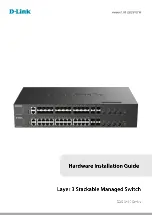
8-port Gigabit Ethernet Switch User’s Guide
37
Layer 1
Layer 2
This is commonly called the switching layer. It allows for the addressing of end stations and for the interconnection of end
stations. This allows a practical way to construct simple but high-performance networks connecting thousands of end
stations.
Switching forwards packets based on the unique Media Access Control (MAC) address of each end station. Switches
records the MAC address and the port number of end stations and enter the information into a lookup table. In this way, a
switch ‘learns’ the location of end stations and other switches attached to its ports.
Switching is usually limited to the Local Area Network (LAN) and requires a routing function to connect to the Internet or
to a Wide Area Network (WAN).
Layer 3
This is commonly called the routing layer. The backbone of the Internet, along with the backbones of the networks of many
large organizations, is built on a layer 3 foundation. The Internet Protocol (IP) is the most important layer 3 protocol. In
addition to layer 2 MAC addresses, each IP packet contains source and destination IP addresses.
IP itself is not a very complex protocol. The IP suite of protocols do, however, provide an extensive range of functions. Some
examples are: the Dynamic Host Configuration Protocol (DHCP) which can assign IP configurations to network devices, the
Domain Name System (DNS) which manages the association of IP addresses with text names, the Routing Information
Protocol (RIP) which enables layer 3 network devices to direct data to destinations in other networks. IP also allows for
transmitting packets from a single point to multiple destinations (known as IP multicasting).
Layer 4
This is commonly called the transport layer. It is responsible for the communication path between user applications and
the network. The Transmission Control Protocol (TCP) and the User Datagram Protocol (UDP) are the most well-known
layer 4 protocols. TCP is a ‘connection-oriented’ protocol. It requires a connection to be established before data is
exchanged. UDP is a ‘connection-less’ protocol. It requires on connection to be setup before it transmits data.
Because UDP does not have the overhead of establishing a connection before transmitting data, it is frequently used for
multicast transmissions.
TCP and UDP also have very different error recovery mechanisms. Both TCP and UDP are layered on top of IP, but IP has
very limited error recovery or detection. TCP keeps track of the transmitted data and retransmits lost or corrupted data.
UDP relies upon the application (at a higher layer) to keep track of transmitted data.
Layer 7
This commonly called the application layer. It provides access to application software running either on a computer or
other network device. Application software usually does not communicate directly with the transport layer, but uses other
software from a communication library, such as the WinSock library.
The application software designers must decide on the type of transport protocol that is most suitable for their task.
Databases, for example, require error-free transmission, so TCP would be the best choice. Multimedia is much less
sensitive to errors, so the low overhead of UDP becomes the best choice.
Содержание DGS-3308TG
Страница 23: ...8 port Gigabit Ethernet Switch User s Guide 13 Figure 4 2 Switch to switch connection ...
Страница 159: ...8 port Gigabit Ethernet Switch User s Guide 149 ...
Страница 160: ...8 port Gigabit Ethernet Switch User s Guide 150 Layer 2 Mode ...
Страница 161: ...8 port Gigabit Ethernet Switch User s Guide 151 ...
Страница 162: ...8 port Gigabit Ethernet Switch User s Guide 152 ...
Страница 239: ......
















































